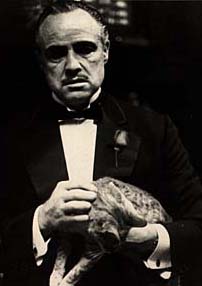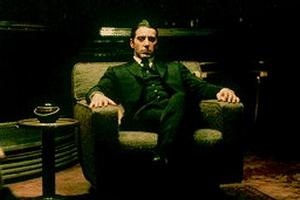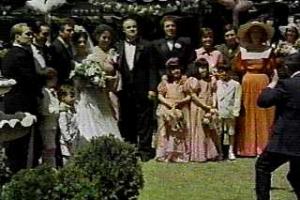
The Godfather: Stereotype or Reality?

Since the invention of motion pictures in 1927, American films have had a "social and cultural impact of society" (Campbell, pg. 192). Not only have movies allowed audiences to escape as Neal Gabler described in his book, Life The Movie: How Entertainment Conquered Reality, he also states,
"It is not any ism but entertainment that is arguably the most pervasive, powerful, and ineluctable force of our time… [it] pulls us in, holding us captive, taking us both deeper in to the work itself and deeper into ourselves, or at least into our own emotions and senses, before releasing us" (pg. 9, 18).
Thus, the creators of entertainment, allows viewers to "escape"
and "pulls [them] in," have also impacted society through the use
of stereotypical portrayals of minority groups.
Much research has been deployed on group portrayals.
Clark (1972) constructed four stages of minority portrayal in the entertainment
industry: non-recognition, ridicule, regulation, and respect. In the non-recognition
stage the minority group is virtual absent in the media; examples of minority
groups include Latinos and Native Americans. As a group, Native Americans are
stereotyped in the media; movies such as Smoke Signals and Last of the Mohicans
exemplify the stereotype. In the second stage, ridicule, characters are seen
as: buffoons, idiots, flat two-dimensional, and are represented as "the
stereotype." Italian Americans as well as gay men are characterized in
the media, which can be seen in movies such as the Godfather and shows like
Will & Grace. In the third stage, groups have a better portrayal; either
in a good or bad image. This would be illustrated through ethnic groups such
as African and Asian Americans. For example, Asian Americans, as Noksyma (1991)
found in his research, are portrayed as intellectuals whereas African Americans
are found to display "socially valued characteristics and high social status
symbols" (Graves, pg. 181). Lastly,
in the fourth stage, respect, groups are portrayed in full diverse role; images
of whites would be in this stage. By constructing the four stages, Clark illustrates
how the entertainment industry has stereotyped images of minority groups into
these stages, which has affected societies image of these groups.
 The standardized mental picture of a group is the definition
of a stereotype, which has transgressed through the media, especially in movies
such as The Godfather trilogy. Thus, using the definition and the word
Godfather should lead one to conger up an image of an organized crime
family, or more specifically, the Corleone family. This association is known
as the dissociation model, which states that a universal stereotype is known
and presented to us (us meaning the audience) by the mass media (Devine,
1989). Thus, The Godfather trilogy have stereotyped Italian Americans
based on this definition and model.
The standardized mental picture of a group is the definition
of a stereotype, which has transgressed through the media, especially in movies
such as The Godfather trilogy. Thus, using the definition and the word
Godfather should lead one to conger up an image of an organized crime
family, or more specifically, the Corleone family. This association is known
as the dissociation model, which states that a universal stereotype is known
and presented to us (us meaning the audience) by the mass media (Devine,
1989). Thus, The Godfather trilogy have stereotyped Italian Americans
based on this definition and model.

There are three quite prevalent stereotypes of Italian Americans in The Godfather films: characters involved with food, family, and violence. Food plays a big part in the trilogy. Characters are seen eating Italian food, mainly pasta in scenes such as the wedding and when Michael kills the Chief of Police. Those who do not have any associations with Italian Americans might stereotype this group as only eating pasta and not other types of food. Family plays a major role in The Godfather. The men are part of the family business, whereas the women are preoccupied with their roles as housewives. Lastly, violence also is stereotyped to Italian Americans through being associated with organized crime. This can be shown through the Italic Studies Institute study of Italian Culture on Film conducted from 1996 to 2001. Their findings illustrate this stereotype.
| Total Italian Related Films since Sound Era (1928) |
1220
|
| Films which portray Italians in a positive light |
374
(31%)
|
| Films which portray Italians in a negative light |
846
(69%)
|
| Individual Categories |
1220
|
| Mob Characters |
487
(40%)
|
| (Real mob characters) |
58
(12%)
|
| (Fake mob characters) |
429
(88%)
|
| Boors, buffoons, bigots, or bimbos |
359
(29%)
|
| Positive or complex portrayals |
374
(31%)
|
|
Influence
of The Godfather (1972)
|
|
| Mob movies prior to The Godfather |
207
(43%)
|
| Mob movies after The Godfather |
280
(57%)
|
| Total Number of Italian Americans (1990 U.S. Census) |
14.7
million
|
| Total Number of Criminals (1999 F.B.I Statistics) |
1,150
(.0078%)
|
Thus, the research shows the cultural impact The Godfather trilogy has had on stereotyping Italian Americans: 846 out of 1220 movies have negatively portrayed this group which his the fifth largest ethnic group in the United States. In addition, the study states "close to 300 movies featuring Italians as criminals have been produced since the success of The Godfather" (Italic Studies Institute).
Ben Lawson chair of both the Italian Studies and Film Studies Department at Purdue University conducted a survey of forty students asking, "Do Mafia movies and television shows such as the Sopranos affect the image of Italian Americans?" Ninety-eight percent of the subjects saw movies or television shows that contained the mafia and replied that the most prominent Mafia movie and or show was The Godfather (56% replied). Lawson then broke down the participants into ethnicity: Italian and not Italian for the question, "Name three things that come to mind when thinking of Italian-Americans." Those with Italian-American ethnicity replied with: "good food, intelligent, charming, easy to get along with, etc." while the non Italian-American heritage replied with: "Mafia, greedy, sneaky, good food, New York, violence, accents, etc." This further illustrates that there is an Italian American stereotype, which has impacted our society.